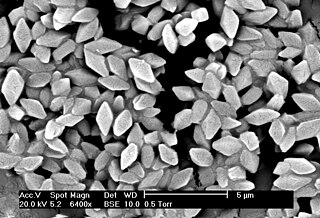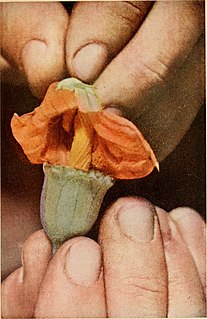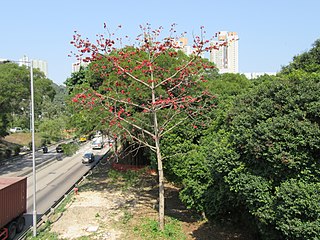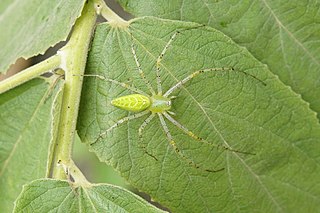
Bacillus thuringiensis is a Gram-positive, soil-dwelling bacterium, the most commonly used biological pesticide worldwide. B. thuringiensis also occurs naturally in the gut of caterpillars of various types of moths and butterflies, as well on leaf surfaces, aquatic environments, animal feces, insect-rich environments, and flour mills and grain-storage facilities. It has also been observed to parasitize other moths such as Cadra calidella—in laboratory experiments working with C. calidella, many of the moths were diseased due to this parasite.

Cotton is a soft, fluffy staple fiber that grows in a boll, or protective case, around the seeds of the cotton plants of the genus Gossypium in the mallow family Malvaceae. The fiber is almost pure cellulose, and can contain minor percentages of waxes, fats, pectins, and water. Under natural conditions, the cotton bolls will increase the dispersal of the seeds.

The Miridae are a large and diverse insect family at one time known by the taxonomic synonym Capsidae. Species in the family may be referred to as capsid bugs or "mirid bugs". Common names include plant bugs, leaf bugs, and grass bugs. It is the largest family of true bugs belonging to the suborder Heteroptera; it includes over 10,000 known species, and new ones are being described constantly. Most widely known mirids are species that are notorious agricultural pests that pierce plant tissues, feed on the sap, and sometimes transmit viral plant diseases. Some species however, are predatory.

Nankeen is a kind of pale yellowish cloth originally made in Nanking, China from a yellow variety of cotton, but subsequently manufactured from ordinary cotton that is then dyed.

Hand pollination, also known as mechanical pollination is a technique that can be used to pollinate plants when natural or open pollination is either undesirable or insufficient.

Bombax ceiba, like other trees of the genus Bombax, is commonly known as cotton tree. More specifically, it is sometimes known as Malabar silk-cotton tree; red silk-cotton; red cotton tree; or ambiguously as silk-cotton or kapok, both of which may also refer to Ceiba pentandra.

Peucetia viridans, the green lynx spider, is a bright-green lynx spider usually found on green plants. It is the largest North American species in the family Oxyopidae. This spider is common in the southern U.S., Mexico, Central America, and in many West Indie islands, especially Jamaica.
Bt cotton is a genetically modified pest resistant plant cotton variety, which produces an insecticide to combat bollworm.

Hylyphantes is a genus of dwarf spiders that was first described by Eugène Louis Simon in 1884. It is distinct from related genera by a pair of spiral copulatory ducts in the female, which are matched by a turbinated embolus in the male. Both sexes are similar in appearance; the male has no modifications.
This is a list of alleged sightings of unidentified flying objects or UFOs in France.
Glomerella graminicola is an economically important crop parasite affecting both wheat and maize where it cause the plant disease Anthracnose Leaf Blight . Certain cereal varieties that have been genetically engineered. may be more susceptible to the teleomorph phase of the fungus.

Zymoseptoria tritici, synonyms Septoria tritici, Mycosphaerella graminicola, is a species of filamentous fungus, an ascomycete in the family Mycosphaerellaceae. It is a wheat plant pathogen causing septoria leaf blotch that is difficult to control due to resistance to multiple fungicides. The pathogen today causes one of the most important diseases of wheat.
Pythium graminicola is a plant pathogen infecting cereals.
E. orientalis may refer to:

Heriaeus is a genus of crab spiders that was first described by Eugène Louis Simon in 1875.
Poaka is a genus of South Pacific intertidal spiders containing the single species, Poaka graminicola. It was first described by Raymond Robert Forster & C. L. Wilton in 1973, and has only been found in New Zealand.

Mecaphesa celer, known generally as the swift crab spider, is a species of crab spider in the family Thomisidae. Its range is quite large, and it is found throughout much of North and Central America.

Heriaeus hirtus is a species of crab spiders belonging to the family Thomisidae.

Punctelia graminicola is a species of foliose (leafy) lichen in the family Parmeliaceae. It grows on rocks, and, less frequently, on bark in North America, South America, and East Africa. It has a blue-grey thallus measuring up to about 15 cm (6 in), covered with tiny pores called pseudocyphellae. Sometimes the lichen forms small lobes that project out from the surface. Fruiting bodies are uncommon in this species; if present, they resemble small cups with a brown internal disc measuring 3–10 mm (0.1–0.4 in) in diameter. A lookalike species, Punctelia hypoleucites, is not readily distinguishable from Punctelia graminicola by appearance or habitat alone; these species can only be reliably differentiated by examining the length of their conidia.
Sarrah Ben M'barek-Ben Romdhane is a Tunisian-Dutch crop researcher. She works on developing fungus-resistant wheat strains to reduce the toll of Mycosphaerella graminicola on yields.













